 |
October 2010
|
October 2010 // Volume 48 // Number 5 // Feature // v48-5a3
Engaging Emerging Populations of Adults with Interactive Activities in a 3D Virtual Learning Environment
Abstract
The Internet, particularly 3D virtual learning environments, has become a venue of choice for many young adults who have grown up in a period of rapidly advancing technology. With this in mind, a 3D virtual kitchen was created to instruct foodservice staff about foodborne hazards. Respondents reported positively about their user experience, the educational content, and the social aspects of the module. The results of this pilot project indicate that engaging young adults with a media in which they feel comfortable is feasible.
Introduction
The Internet, particularly 3D virtual environments, has become the learning venue of choice for many young adults who have grown up in a period of rapidly advancing technology. With a predicted 80% of Internet users engaged in a "second life" in a virtual community by the year 2012 (Gartner, 2007), this medium is expected to have an increasing role to play in adult education. Conventionally, Extension has provided the community with life-saving food safety information in traditional face-to-face settings. In light of the continuing threat of foodborne outbreaks, food recalls, and food contamination, all people need access to research-based food safety information. Information must be presented in a way that is usable to the individuals requiring the information. The emerging population of technology-savvy adults is difficult to engage with traditional Extension programming (P. West, personal communication, February 8, 2010), thus this project deals with the feasibility and effectiveness of engaging young adults with food safety information presented through a media with which they feel more comfortable.
Although numerous researchers have studied the effectiveness of a multimedia interactive learning environment, the focus has been on comparing this teaching method to traditional methods. McCann (2007) found that a highly interactive, multimedia-rich online learning environment was as effective at increasing knowledge as face-to-face and a minimally interactive environment. Most of McCann's participants reported having previously not taken an online course before, and several had negative attitudes about online learning from the beginning (McCann, 2007). The utility of this information is limited because typical learners in virtual learning environments are there by choice, not because they were assigned the virtual learning environment as part of an experimental group of a study.
Because adult students who voluntarily engage in an online learning community for information may be more inclined to learn in this manner, the study reported here recruited participants who were already engaged in the online community. A small 2008 study using six business students found that 100% of participants found the experience enjoyable, thought it was a good idea, increased their engagement in the course, and increased learning (Jarmon, Traphagan, & Mayrath, 2008).
Virtual learning environments may excel by being better suited to meet the social needs of learners. Due to the remoteness of our communities, people look forward to attending educational sessions for the social aspects, as well as for the educational content. Young adults have grown up socializing using computers through chat, instant messaging, email, and social networks. Extension programming will need to adapt content and social opportunities to the media to which these learners are accustomed.
Virtual learning communities have the potential to transform Extension programming much the same way that video conferencing did in the eighties and nineties. Virtual communities have an even greater potential impact because of the added benefit of social interaction and belonging to a community. In 1999, Torrel and colleagues emphasized the importance of social interaction in traditional Extension programming (Torell, Bruce, & Kvasnicka,1999). More recently, DeLucia and colleagues evaluated the use of Second Life as a learning venue for a synchronous distance education class. The researchers concluded that learning is strongly associated with the perception of belonging to a learning community that is promoted by the availability of social interaction (De Lucia, Francese, Passero, & Tortora, 2008).
Because 3D virtual learning communities are exceptionally versatile, they have the potential to reach additional audiences of non-traditional learners. Keefe's (1979) identification of three dimensions of brain function—cognitive, affective, and physiological (perceptual)—lays the foundation for instructors to develop educational materials that better meet the needs of learners. Although innumerous learning styles have been identified by researchers (Barbe & Malone, 1981; Briggs-Myers, 1999; Gregoric, 1999; James & Blank, 1993; Kolb, 1999), Fleming and Mills (1992) reported that students often attributed learning to the form in which the course material was presented—oral, written, graphical, or experiential.
Identifying these areas in the perceptual or physiological dimension allows educators to better focus instructional design and involve a variety of materials in their presentations in order to meet the needs of diverse learners. Current instructional media, including DVDs, video tapes, video conferencing, PowerPoint presentations, written handouts, and satellite broadcasts, tend to reach learners with an auditory, visual, and/or read/write modality. Three-D virtual learning environments offer experiential learning through the manipulation of virtual objects by clicking and dragging, and thus have the potential to reach learners through all four learning modalities—auditory, visual, read/write, and kinesthetic.
An added benefit of using virtual communities for training is the reduced cost of content development. The initial cost of producing a training module in a virtual community is similar to the cost of producing traditional materials such as videos, slide presentations, and handouts. The assistance of technology support staff and graphic design personnel are enlisted in much the same way as in the production of traditional media. Because materials are developed online, travel costs may be reduced because there is no need for travel among collaborators. Long-term costs may also be reduced. A significant advantage of Web-based technologies, including virtual communities, is the ease of updating material. While it is time consuming and expensive to update print or video materials, Web-based information may be updated easily and at any time. Additionally, costs are reduced for training attendees because travel expenses may be eliminated.
In the pilot study reported here, a commercial kitchen was created in a 3-D virtual community called "Second Life" in order to teach participants about foodborne hazards. Because the use of virtual communities for adult education is relatively new to research, the project dealt with the feasibility and effectiveness of engaging young adults with a media with which they feel comfortable. The activity, termed "Virtual Food Inspector Game," was created to allow participants to travel around the virtual kitchen and locate hazards in much the same manner as a real life food inspector would. Upon completion of the activity, evaluation of user perception, social interaction, and educational content of the virtual learning module was accomplished through a chat-based survey instrument.
Project Objectives
- Develop an interactive learning experience in a 3D virtual learning environment
- Develop instructional content to accompany the learning module
- Develop an evaluation tool to measure the functionality, perception, and content of the learning module.
Methods
Recruitment of Participants
It is difficult to obtain demographic information about Second Life residents because membership is completely anonymous. However, market research conducted through the participation of volunteers reveals some limited information. According to the Social Research Foundation, the general population of the Second Life community is predominantly male, earns less than $75,000 per year, and has at least a high school diploma (Social Research Foundation, 2007). Participants were recruited from the general population of Second Life via an announcement on a public bulletin board that stated the time, date, and stipend for participation in the activity. Participants were paid 250 Lindens, or about $1 each for their participation. When the recruits clicked on the bulletin board, they were given a "notecard" containing more information about the activity and how to volunteer. A notecard is the primary means of instantly disseminating written information in this community.
Activity Design and Educational Content
Participants wishing to volunteer for the activity were teleported to a virtual house on Morrill Island, where they viewed written instructions to watch a video for further information (Figure 1). After watching the video, participants proceeded to the virtual diner across the street to begin searching for foodborne hazards (Figure 2). Upon entrance, participants found several customers, a waitress, and a cook chatting about what is safe to eat in the diner (Figure 3).
Figure 1.
Participants Viewing the Video

Figure 2. Outside of the Diner
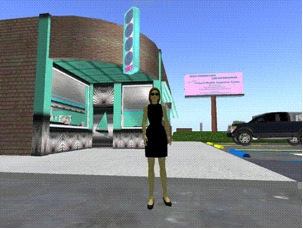
Figure 3.
Interior of the Virtual Kitchen
(Note the Cook, Waitress, Customers, and Inspectors)
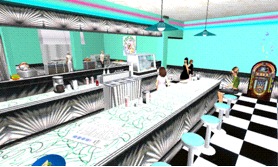
The chat-based communication was used by the project coordinators to provide hints to the participants and provide additional social interaction. When participants clicked on a hazard, they were given a notecard explaining the hazard and the proper way of handling the given situation (Figure 4). Some of the notecards contained passwords at the bottom that were needed to complete the survey. This security measure was necessary to prevent participants from going directly to the survey without participating in the activity.
After locating all 16 hazards, participants continued outside the diner to call the virtual inspector's office from a phone booth. There they were given audio instructions to teleport to the County Inspector's Office to file their report, where they viewed a second video instructing them how to fill out the survey. The time necessary to complete the activity varied between 10 and 20 minutes. The survey was completed by all participants in less than 5 minutes.
Figure 4.
Notecard Given to Participants
When They Click on a Hazard

Evaluation and Statistical Analysis
In the past, learning modules of this type have been evaluated as asynchronous activities. However, in order to capitalize on the social advantage this media has to offer, participants were asked to go through the activity as a group but fill out the survey independently. This evaluation scheme is new to eXtension and offered some unique challenges to prevent participants from cheating.
Because a chat-based survey instrument was used to collect data and chat may be viewed publicly in the Second Life community, it was necessary to teleport avatars (3D virtual representatives of participants) to a different virtual location. Additionally, at the completion of the activity, participants were able to unscramble a code that was needed to access the chat-based survey. Changing the location for the chat-based survey and requiring a key to access the survey, prevented participants from bypassing the activity.
Evaluation of user perception, social interaction, and educational content of the virtual learning module, was accomplished through a chat-based survey instrument (Figure 5). Five questions were asked from each realm. These three realms were chosen to evaluate the pilot project due to the factors identified in the literature as being important to learning.
Questions related to user perception were asked to determine if the interactive elements functioned correctly and users felt a high degree of presence in the virtual environment. Questions related to social interaction were asked to determine if participant's social needs were being met during the activity. Questions related to content were asked to determine how well the information was presented.
Participants were given one questions at a time via chat and asked to score their level of agreement on a five-point Likert scale. This portion of the survey instrument was validated using the card sort method. Using the card sort method, an experienced adult educator was asked to sort a randomized list of the questions into the three realms in a way that makes sense to them. The instrument is considered valid if the questions are placed in the correct categories. Additionally, two demographic questions were asked to reveal the Second-Life and real-life experience of participants. A census survey was used to collect data from each participant visiting the Virtual Inspector Kitchen.
All 16 participants who began the activity successfully completed the survey. The data was compiled and summarized to reveal trends. A chi-square test was conducted to reveal differences in participant response by amount of experience in Second Life, however, the sample size was insufficient to identify statistical differences.
Figure 5.
Chat-Based Survey Instrument
Questions
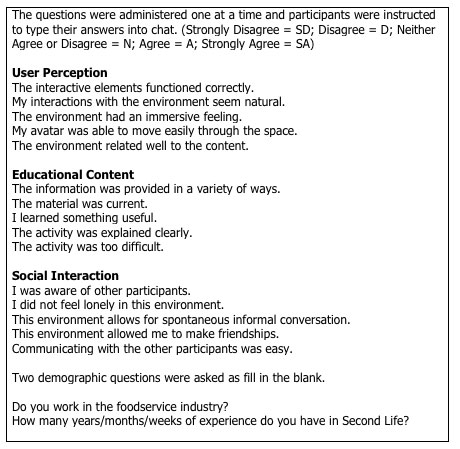
Results and Discussion
Most participants (10 of 16) had between a few months and a few years of experience in the virtual community prior to completing the activity. Interestingly, participants who reported the activity was too difficult were not those who had the least experience in the community. Only four out of 16 participants worked in the foodservice industry.
Participants reported positively about their user experience. Twelve of 16 participants agreed or strongly agreed that the interactive elements functioned correctly, their interactions with the virtual environment seemed real, their avatar was able to move easily through space, the environment had an immersive feeling, and the environment related well to the content (Figure 6). These positive findings promote the use of virtual environments for providing experiential learning because the user feels a great deal of presence, or they are immersed in the space. The idea that increased immersion will improve learning has its roots in traditional social learning theory. Seligman (1970) reported learning is improved by prompting responses that are natural for the learner in a given situation. Although Seligman studied the responses of animals to different stimuli, a similar preparedness continuum may be applied here. Those growing up having been exposed to computers their whole lives are prepared for a virtual learning environment by their past experiences.
Figure 6.
Participant Scores by Question
Related to the Realm of User Perception

The educational content was found to be appropriate and useful. Eleven out of 16 participants agreed or strongly agreed that the information was provided in a variety of ways, the material was current, they learned something useful, and the activity was explained clearly. Ten out of 16 participants disagreed or strongly disagreed that the activity was too difficult (Figure 7). Participant comments revealed that they thought the activity itself was not difficult, but the evaluation scheme was somewhat complex.
Figure 7.
Participant Scores by Question
Related to the Realm of Educational Content
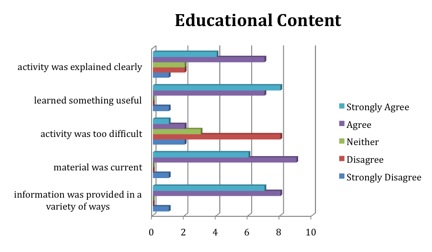
Participant responses to questions related to the realm of social interaction indicated that participants' pro-social needs were met in this environment. Ten out of 16 participants agreed or strongly agreed that they were aware of other participants, they did not feel lonely in the virtual environment, the environment allowed for spontaneous informal conversation, and that communicating with other participants was easy. However, 14 out of 16 participants did not have a strong opinion either way that the environment allowed them to make friendships (Figure 8). The activity announcement stated that the first 20 participants to complete the activity would receive the stipend. It is possible that this created a competitive environment in which participants were hesitant to communicate with one another. Very little communication among participants was observed in public chat; however, it cannot be determined if the participants were communicating in private chat.
Figure 8.
Participant Scores by Question
Related to the Realm of Social Interaction
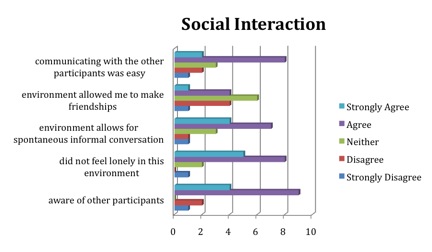
Conclusion
The learning module will be included as part of a larger project involving the establishment of an eXtension Community of Practice. The larger project will incorporate public and private chat, communication with a food safety expert in real time, and learners and educators working as a collaborative group. These added methods of communication and socialization will be beneficial for learners to perceive that they are members of the community. The online virtual learning community also lends itself well to the incorporation of evaluation tools such as online surveys to assess the effectiveness of the project as a learning tool.
Future studies will focus on enriching the asynchronous activity by encouraging participants to communicate with one another. Additional priorities will be the development of an evaluation scheme to measure knowledge and impact. The lessons learned in this unique attempt at evaluating the social component of the activity will be useful in the consideration of future evaluations. Specifically, the use of a chat-based survey shows that it is possible to obtain immediate data compared to the traditional method of following up with an email survey. Because there was a 100% response rate on the chat-based survey, the results are more accurate compared to an emailed survey, which would typically have a much lower response rate.
Acknowledgements
This project could not have been completed without the assistance of LuAnn Philips, Information Technologist, eXtension, and Dmitre Raposo, Professional Photographer and Graphics Designer, eXtension. These two professionals developed the graphic content, originated the evaluation scheme, and contributed countless hours assisting with the evaluation and troubleshooting challenges that arose with the unique nature of this type of educational media. For information on how to become involved with eXtension in Second Life, contact LuAnn Philips at luann.phillips@extension.org.
References
Barbe, W. B., & Malone, M. N. (1981). What we know about modality strengths. Educational Leadership, 2, 378-380.
Briggs-Myers, I., & McCaulley, M. H. (1985). Manual: A guide to the development and use of the Myers-Briggs type indicator. Palo Alto, CA: Consulting Psychologists Press.
De Lucia, A., Francese, R., Passero, I., & Tortora, G. (2008). Development and evaluation of a virtual campus on Second Life: The case of SecondDMI. Computers and Education, 52(1), 220-233.
Gregoric, A. (1999). Gregoric style delineator. Columbia, CT: Gregoric Associates.
James, W. B., & Blank, W. E. (1993). Review and critique of available learning-style instruments for adults. In D. D. Flannery (Ed.) Applying cognitive learning theory to adult learning pp. 47-57. New Directions for Adult and Continuing Education, No. 59. San Francisco, CA: Jossey-Bass.
Jarmon, L., Traphagan, T., & Mayrath, M. (2008). Understanding project-based learning in Second Life with a pedagogy, training, and assessment trio. Educational Media International, 45(3), 157-176.
Keefe, J. (Ed.). 1979). Student learning styles: Diagnosis and prescribing programs. Reston, VA: National Association of Secondary School Principals.
Kolb, D. (1999). Learning style inventory 3. Boston, MA: Hay Group.
McCann, B. M. (2007). The effectiveness of Extension in-service training by distance: Perception versus reality. Journal of Extension [On-line], 45(1). Article 1FEA4. Available at: http://www.joe.org/joe/2007february/a4p.shtml
Press Release: Gartner says 80 percent of active Internet users will have a "Second Life" in a virtual world by the end of 2011. (2007). Retrieved February 6, 2009 from: http://www.gartner.com/it/page.jsp?id=503861
Seligman, M. P. (1970). On the generality of the law of learning. Psychological Review. 77(5), 406-418.
Social Research Foundation First Opinions Panel Membership Analysis (2007). Retrieved April 1, 2009 from: http://www.socialresearchfoundation.org/fop_analysis.html
Torell, R., Bruce, B., & Kvasnicka, B. (1999). Promoting and organizing agricultural extension meetings. Journal of Extension [On-line], 37(1), Article 1TOT1. Available at: http://www.joe.org/joe/1999february/tt1.shtml




